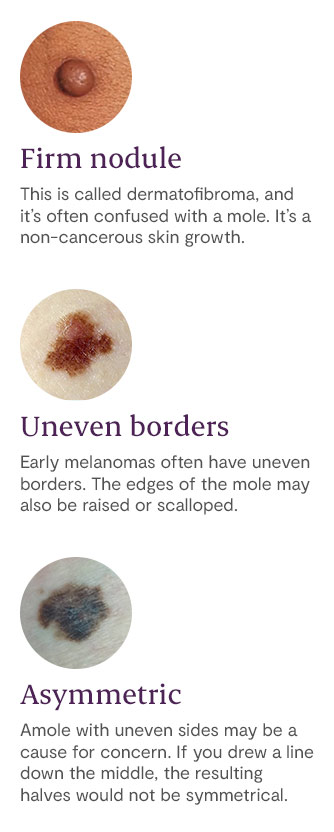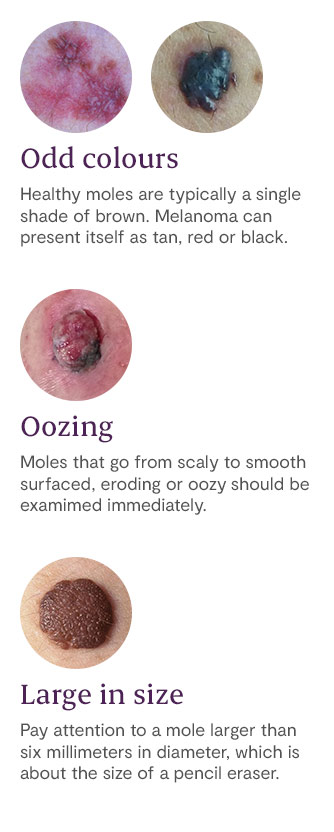See all > Skin and hair care

What’s your mole telling you?
Moles are small, usually dark skin growths that appear all over the body. The average adult has 10-40 moles, so there’s usually nothing to worry about if you have a few yourself. Moles are most often benign, meaning they’re non-cancerous. But, they can also be a warning sign for the most dangerous type of skin cancer: melanoma.
Risk factors for melanoma
An estimated 7,800 Canadians are diagnosed with melanoma each year. That’s why it’s important to see a dermatologist annually if you have risk factors for skin cancer. These risk factors include:
- Age between 35-75
- Light skin
- Blond or red hair
- Family history of skin cancer
- Having severe sun damage in the past
- History of tanning bed use
When to see a doctor about a mole
If a suspicious mole pops up on your skin, you might be wondering whether it warrants an emergency trip to a dermatologist. While most moles are nothing to worry about, there are a few warning signs to watch out for. If your mole is showing any of the following traits, call a dermatologist or see one virtually.
Signs of melanoma
There’s a simple way to remember the main signs of melanoma. You just have to know your ABCDEs.
- A – Asymmetry: Healthy moles are usually symmetrical.
- B – Border: Raised or scalloped borders are atypical in moles.
- C – Colour: Healthy moles tend to be a uniform shade of brown. Dark moles, or moles with many colours, might be cancer.
- D – Diameter: Pay attention to moles larger than six millimeters in diameter.
- E – Evolution: A mole that suddenly appears, grows, or changes colour or shape should be investigated.
Another sign to watch out for is how your mole feels. If it hurts or itches, that could be an indicator of something serious.


Preventing skin cancer
Dermatologists recommend “knowing your skin” as a first line of defense against skin cancer. This means you should keep track of how many moles you have, and if any of them are changing in worrisome ways. That way you’ll be able to tell if something is awry.
It’s important to protect your skin year round to reduce your chances of developing a melanoma. Ultraviolet rays are the main environmental factor in skin cancer. So, good sun habits are essential.
- Wear sunscreen of at least SPF 30 everyday, even in winter or on cloudy days.
- Avoid exposure to midday sun, when UV rays are strongest.
- Cover your skin with long layers of clothing.
- Wear a wide brimmed hat.
- Avoid tanning beds.
- Protect kids from sun burning, as even one bad sunburn early in life can double their chances for melanoma down the road.
What if a mole is cancerous?
Thanks to improved skin cancer awareness, dermatologists are able to intervene earlier in cases of melanoma. When melanoma is caught early, the five year survival rate is an expected 98%. The survival expectancy drops when melanoma has spread to different parts of the body. That’s why it’s important to see a dermatologist regularly, especially if you have a suspicious mole on your body.
Unfortunately, Canadians wait an average of 90 days to see a dermatologist. That’s too long to wait if you have a potentially dangerous skin concern. Another option is seeing a dermatologist virtually. With Maple, you can see a dermatologist in less than 72 hours and get a diagnosis. Best of all, you don’t even have to leave your home. If you have a skin concern, need a prescription, or simply have questions, our doctors are here for you.
The information presented here is for educational purposes and is not meant to replace the advice from your medical professional.
When using virtual care, all medical treatment is at the sole discretion of the provider. Virtual care is not meant for medical emergencies, and your provider will determine if your case is appropriate for virtual care. If you are experiencing an emergency like chest pain or difficulties breathing, for example, please call 911 or go to your nearest emergency room.
Trusted by millions of Canadians
Get started now

We're trusted by millions of Canadians
Join millions of Canadian families who enjoy 24/7 access to medical care within minutes.
Get started now4.6 score
5K+ Trustpilot reviews
Do you need medical care today?
Trusted, experienced doctors and nurse practitioners are ready to see you.
